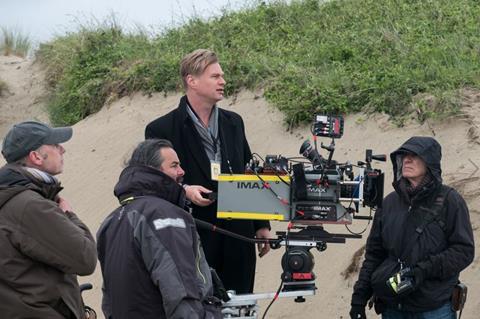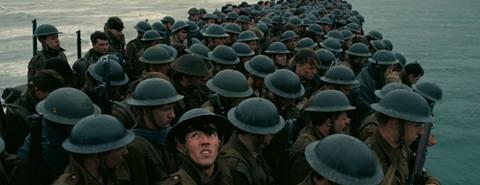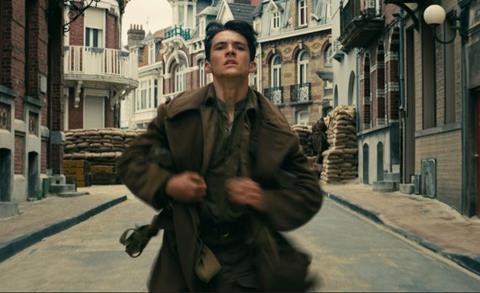Dunkirk is the latest release in the new and rather specialised sub-genre of war films pushing film technology in new directions.
Following Ang Lee’s high framerate experiments with Billy Lynn’s Long Halftime Walk last year, Christopher Nolan’s latest film Dunkirk goes back to the future by being his first movie shot almost entirely on 70mm Large Format film.
70mm has of course a long and noble cinematic history, with some of the most memorable movies ever made, from Lawrence of Arabia to The Sound of Music to 2001, being shot in the format.
And Nolan has, of course, experimented with 70mm before, with sections of all his movies from 2006’s The Prestige on being shot on 15 perf IMAX, a 65mm stock that is then printed onto 70mm stock for projection.
Dunkirk, which details the events surrounding the evacuation of 300,000 Allied troops back to England from French beaches in 1940, takes that interest to another level.

What is interesting to note is the way that the format has shaped the way the film has evolved; the noise of the cameras as the film rattles through the gate four times faster than conventional 35mm, for example, being a large part of the reason why there are so few dialogue scenes in the film. Not that Nolan has ever been overly daunted by the physicality of it all.
“For years, filmmakers who wanted to shoot digital would promote the fact that the cameras are lighter, easier or whatever,” he said at a BFI conference in 2015.
“But my response would always be, If David Lean, or rather David Lean’s crew, can put a 65mm camera in the desert, why should I care that your camera is lighter, unless you’re doing something with it you couldn’t do before.”
IMAX cameras are many things but light is not one of them. While dialogue scenes were shot using a smaller Panavision 5 perf 65mm camera, roughly 70% of the rest of the movie was shot on a mainstream 24kg IMAX MkIII unit. All of which makes DoP Hoyte van Hoytema’s feat in filming a lot of the movie handheld all the more impressive.
“Hoyte hand-held the [IMAX] camera for a few sections of Interstellar very effectively, and then on this I had to break the news to him that he was going to be doing it for a massive amount of the film,” Nolan told Entertainment Weekly. “We definitely bought him a lot of massages along the way.”
IBC2017 IBC Big Screen is a four-day conference for executive level, decision-making motion-picture professionals. For more information and to register for your pass click here
Steadicam was also used, but the engineering feat was as impressive.
Lightweight mounts were developed to mount two IMAX cameras on the wings of an aircraft to capture dogfights, with special ‘snorkel’ lenses allowing for glimpses into the cockpit. A new, underwater housing was developed alongside stabilisation systems for the boat-mounted shots.
Such knowledge is fairly hard-won.
In an era when even the highest range digital cameras are thoroughly commoditised and their specs pored over in intricate detail, IMAX information is sparse.
This becomes more understandable when you realise that the number of IMAX cameras worldwide is probably measured in the low 10s, but also explains why there is a ready information exchange between the directors working in the format.
Paul Thomas Anderson released Inherent Vice in 70mm, Quentin Tarantino made The Hateful Eight in 70mm Cinerama, and JJ Abrams (The Force Awakens) and Zach Snyder (Batman vs Superman) have both used the format for sections of their films.
Nolan says he spends a lot of time talking to Anderson and Tarantino about maintaining the photochemical process, and has even lent a special IMAX lens he owns to Abrams and Snyder.

“We all learn from each other,” he told film magazine Little White Lies in a wide-ranging interview on Dunkirk and the subject.
“There’s a lot of interesting collaboration that goes on. As photochemicals come under such pressure and such threat from economic forces – those not wanting to deal with it from a business or an industrial point of view – filmmakers have had to stand up and be counted.”
”I’m making my films cheaper than anybody working at the same scale on digital” - Christopher Nolan
Nolan and other’s adoption of 70mm can also be seen in the wider context of a resurgence in interest in all things celluloid that saw nine movies captured on 16 and 35mm Kodak film stocks alone, from La La Land to Suicide Squad, receive 29 Academy Award nominations this year.
As that list shows though, this is more than simply an auteur-led movement: this is seriously mainstream. Wonder Woman, for example, was shot on film, director Patty Jenkins saying: “It’s because there’s a certain type of epic grander escapism that film gives you that you cannot — you will struggle very hard — to get that on video.”
Kodak, as the only manufacturer that survived from the celluloid heyday (Fujifilm quit in 2013), is understandably making the most of all this, and it has been quite a turnaround.
In 2015 it signed a deal with the major US film studios that saw them guarantee to buy a certain level of film stock. And it has gone from that survival lifeline to recently acquiring a film-processing lab in Atlanta, Georgia, to service The Walking Dead and other major film and television productions, building an entirely new film lab in New York, and signing a five-year lease on part of the Ken Adam Building at Pinewood Studios to establish a new film negative processing lab.
The forthcoming The Last Jedi was a 35mm production, the next 10 Star Wars films probably will be, the new Bond will be too, so having a dailies processing lab on site makes sound economic sense all round.
It also highlights some of the difficulties of working with celluloid as opposed to digital though, which were simply exacerbated for Nolan on location in 70mm.
“We were able to watch dailies in France as we had a very good 70mm projector which we took around with us,” he says. “You’re watching dailies from a few days before as it takes a while to get them processed and back to set.”
Nolan also tried to make sure that as much material was shot in-camera as possible, though London’s Double Negative has produced some truly stunning work on the movie.
He also chose to skip the digital intermediate process and rely on lab colour timing for the film version, DI only swinging into play for the digital deliverables — Dunkirk is being presented in IMAX 70mm, standard 70mm and anamorphic 35mm, as well as digital formats — and briefed to grade as close as possible to the film version.

Despite all this added attention to detail Nolan has little time for the argument that digital production is cheaper than film, especially when you’re mounting a seriously large scale production such as Dunkirk, whose $150m budget included the marine construction of massive sections of the Dunkirk Mole used to evacuate the Allied forces from the beachhead.
“As far as the cost, it’s a complete fallacy. I’m making my films cheaper than anybody working at the same scale on digital
”There are no efficiencies to be gained there and no money to be saved,” he told Little White Lies.
“There’s been an aggressive fight against photochemicals by companies who make money by change,” he continued.
“They make money by selling you new equipment and building new equipment. The studios saw an opportunity to stop paying as much for release prints and follow more of a television model where you’re broadcasting films rather than physically shipping them. But all of that’s irrelevant.
“I gave a speech some years ago where I was asked to defend film, and I said that I felt like a stonemason defending marble. It’s ridiculous. This is why we’re all here. It’s what we do. This is film. Every digital format so far devised is just an imitation of film.”
























No comments yet